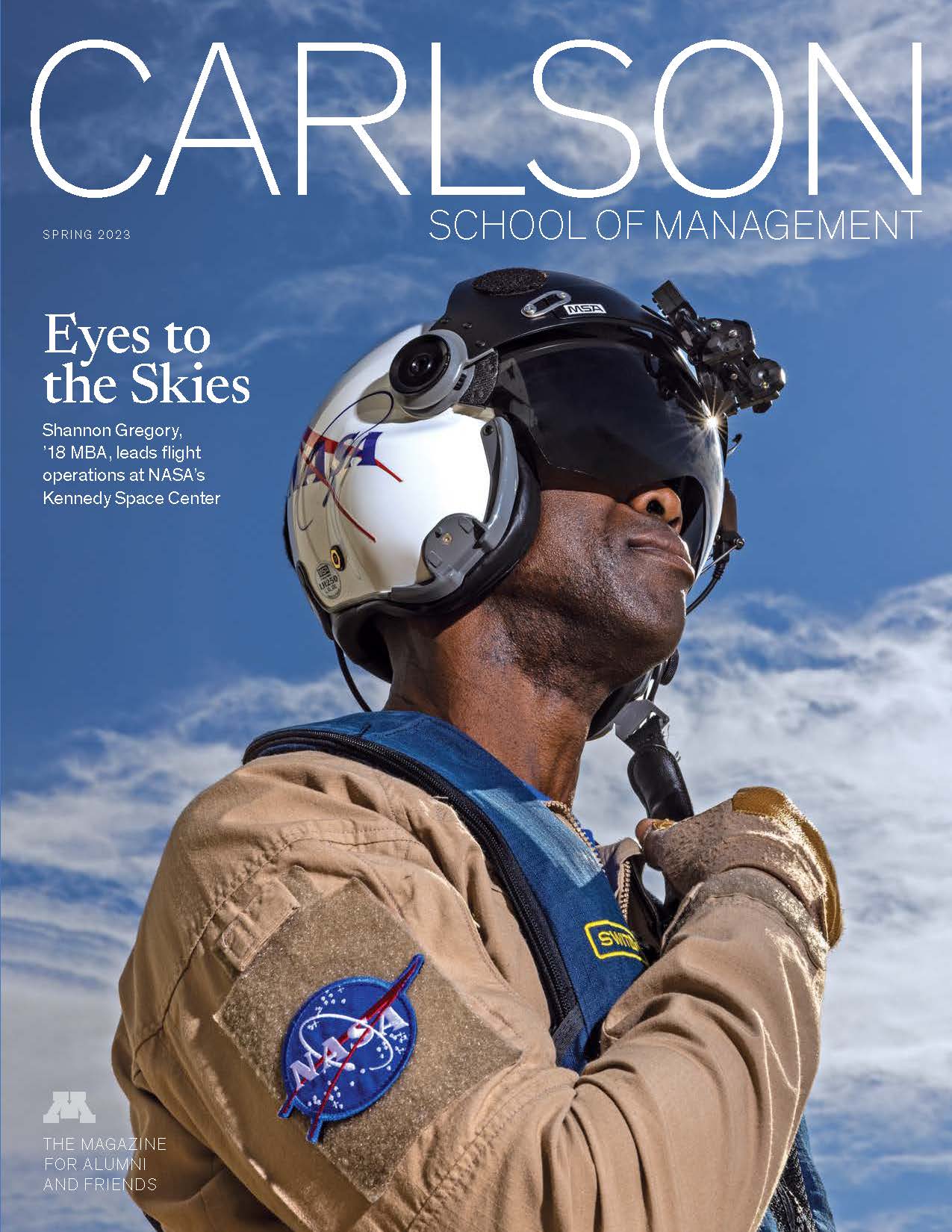
What Are We Watching?
Friday, April 21, 2023
By Gene Rebeck
The media world is transforming in surprising, exciting ways. But with new opportunities for content creators come some old worries.
Netflix. Hulu. Disney+. Amazon Prime Video. AppleTV+. HBO Max. Those are just some of the streaming options we have today. And we can’t forget social media options or “traditional” media outlets. It’s a consumer cornucopia of choice, wherein you can watch nearly anything you want, at any time, and from anywhere (as long you pay for it).
Each of these companies, and many others, have the same goal: create “persistent, engaging content,” as Tom Staggs, ’82 BSB, co-founder of Candle Media, puts it. There are many layers and players in this space, with their own opportunities and challenges. “[Everyone is] competing for the time and attention of consumers,” says Staggs, a former C-suite leader at The Walt Disney Company. “The opportunities to reach consumers will continue to grow.”
Opportunity Opens
This proliferation of publishers has been years in the making. In the early days, Staggs and Kevin Mayer, also a former Disney C-suite leader, looked closely at the rise of streaming. They noticed major platforms such as Amazon and Netflix were focused on producing their own programs and movies. “At the same time, there was this demand for significantly more content than any one producer could generate for themselves,” says Staggs, who was Disney’s chief operating officer at the time. “That opened up an opportunity for independent content creation.” It also led to creators owning their work and broadcasting it online through YouTube, Facebook Watch, and Instagram’s IGTV.
Staggs notes the “increasing access to audiences” allows independents to “create community around content and creators” while “lower[ing] barriers to creating commerce opportunities from that community.” These trends, he adds, “felt like a very good opportunity to develop premium intellectual property that reaches audiences, serves the needs of streamers, and creates ancillary revenue streams.”
In July 2021, he and Mayer launched Candle Media, which has majority ownership in 10 streaming content companies and a minority stake in another. The largest of these companies is children’s entertainment producer Moonbug, whose best-known program, Cocomelon, features animated nursery rhymes and kids’ songs. Moonbug is “digital first,” explains Staggs, noting that the franchise was launched on YouTube, where it now has 153 million subscribers, the second most of any channel on the site. “It has created a real audience around that content. And then they take that content, own it, and broaden its reach both on YouTube by going into other geographies and languages, and also by spinning off content and packaging it for streaming.”
Candle Media’s second-biggest holding is Hello Sunshine, a production company co-founded by actor Reese Witherspoon that’s focused on women creators and woman-centered stories. Across its portfolio, Candle Media is boosting production capabilities and developing ancillary revenue streams around their content. “We try to leverage our experience at Disney both in scaling an enterprise but also in building content-driven brands,” Staggs says, while also seeking “opportunities to develop synergy between the different businesses.”
(Yes, a Cocomelon version of a Reese Witherspoon children’s book is in the works). To be a content-driven brand, talented people are needed both in front of, and behind, the camera.
Inclusivity is “not only the right thing to do, but an opportunity to pursue new ideas and audiences.”
New Niches Grow
Mike Moh, ’05 BSB, is another Carlson School grad who has found success in the evolving media landscape. As a student, he found his calling during a corporate internship gone awry. “I was not fit for an office environment,” recalls Moh. So, he began exploring the possibility of turning his love of martial arts into an entrepreneurial opportunity. Through his participation in martial arts competitions he “was discovered by someone who was connected to Jackie Chan.”
Soon Moh was in Hong Kong to work on a stunt team in a Chan movie—and it was there that he caught the acting bug. Since 2009, he has performed in numerous movies and TV shows. This year, he’ll have a major role in Ghosted, a new “romantic action-adventure film” on Apple’s TV+ streaming service. Moh credits much of his success to the expansion of media that has opened up new opportunities for actors with diverse backgrounds. Moh says streaming services face “less pressure from the box office,” adding that inclusivity is “not only the right thing to do, but an opportunity to pursue new ideas and audiences.” New Carlson School research bears this out, finding that there’s a growth in “middle-tail” streaming content, meaning movies with budgets between $100,000 and $10 million that are attracting audiences without being blockbusters.
A 'Democratized' Market?
Musicians and writers also have been finding new ways to market their work in digital media. Joel Waldfogel, the Carlson School’s associate dean of MBA programs and a professor of strategic management and entrepreneurship, has been studying digitization of media since the early days of the internet. The movie research above is his, co-authored with Professor Mary Benner. In recent years, Waldfogel says he’s seen “an explosion of creative production.”
What’s driving that? “A lot of it is the technology of distribution and promotion. You don’t need to get a movie studio to agree or a record store to agree,” Waldfogel says. “You can just distribute your work through online platforms. It became a democratizing world where everybody could create and distribute stuff.” Waldfogel has paid particular attention to Spotify.
“In the old world, maybe a couple hundred artists got significant airplay on the radio,” he notes. “In this new world, we have Spotify ingesting millions of songs a year.” Getting on a Spotify-curated playlist can provide access to new audiences for artists overlooked by record companies. Musicians also have been using platforms like Bandcamp and SoundCloud to promote their work.
Waldfogel notes that Amazon’s direct-publishing program via its Kindle has proven a successful platform for many self-published authors. “Lots of people are finding success circumventing the traditional gatekeepers,” he says. “The new gatekeepers are the platforms.”
But might those platforms decide to limit access to less high-profile content creators? Waldfogel’s research suggests that that’s not the case—not yet, anyway. Spotify, for instance, does use algorithms and human-created lists that promote some music more than others, but it doesn’t seem to be biased. “But it’s also true that the platforms have an enormous amount of power to affect which things become very successful,” he notes.
Tech does have a history of winnowing competition: Microsoft’s dominance of computer operating software, for example. Social media platforms have become highly competitive—and highly concentrated. (Instagram is owned by Facebook parent Meta, after all.) Meanwhile, Twitter remains the dominant microblogging site, and despite its long-predicted demise and current turbulence, it’s still considered the best place for writers to promote their work, whether that appears in print or their own pay-to-read newsletters on platforms such as Substack.
Lots of people are finding success circumventing the traditional gatekeepers.
From Finance to Fashion
It’s not just traditional forms of media that are finding new, profitable ground. As an undergraduate at the Carlson School 16 years ago, Maria Vizuete, ’07 BSB, couldn’t have specialized in her current
field. It simply didn’t exist yet.
Vizuete was working as a stock analyst in Los Angeles covering retail for Minneapolis–based investment firm Piper Jaffray (now Piper Sandler) in the early 2010s.
“I heard a lot of CEOs talk about how important fashion bloggers were becoming,” Vizuete says. “They were placing an emphasis on partnering with influencers—in many instances because [influencers] were giving [fashion brands] free press.”
As someone who’d always loved fashion as well as finance, Vizuete was intrigued. She began to look into how blogging and influencing could be monetized. She soon saw that it was potentially remunerative, as fashion retailers looked to connect their brands and garments with online fashionistas. So Vizuete left her financial services career in 2016 to become a full-time fashion blogger and influencer via her online brand, Mia Mia Mine.
Retailers have found influencers, such as Vizuete, offer a more targeted way to reach customers than traditional advertising. Her revenue comes chiefly from two buckets: affiliate commissions (where retailers pay her commission on the sales she drives to their website) and brand collaboration (where retailers pay her to shoot campaigns to promote their brands on her social media and website).
She’s attracted a number of big-name brands, including Nordstrom, Express, and Abercrombie & Fitch.
With millions of online followers, she’s developed a business that allows her to make more money than she did at Piper, and she’s making it work in the Twin Cities.
Vizuete says she’s built up her following largely through her use of street-style fashion photographs shot in Minneapolis and St. Paul. Minnesota’s capital city, in particular, can project a global sophistication thanks to its older downtown buildings. “A lot of people thought I was based in New York or Europe,” she says. This international flavor helped spread her images widely. “I attracted a lot of fashion accounts who had millions of followers, so I’d gain followers through their audiences,” Vizuete says.
The Only Constant is Change
In many ways, Vizuete’s story reflects not solely the changes in how retailers reach consumers—it’s evidence of how digitization is changing the broader media landscape. Those changes have
created new commercial opportunities for creators of content, whether that content is music, books, video, film, or even journalism. And they don’t have to operate in major media capitals: These creators are building communities around their often-global followers and making a living from them.
And the only constant, of course, is change—and the media landscape is no exception to that rule.
Vizuete, for one, believes she’ll be ready for whatever evolves. She credits her business education and finance career with helping her succeed as an influencer. “The business will definitely transform over the next decade,” Vizuete says. “But having that background will help me navigate that.”




